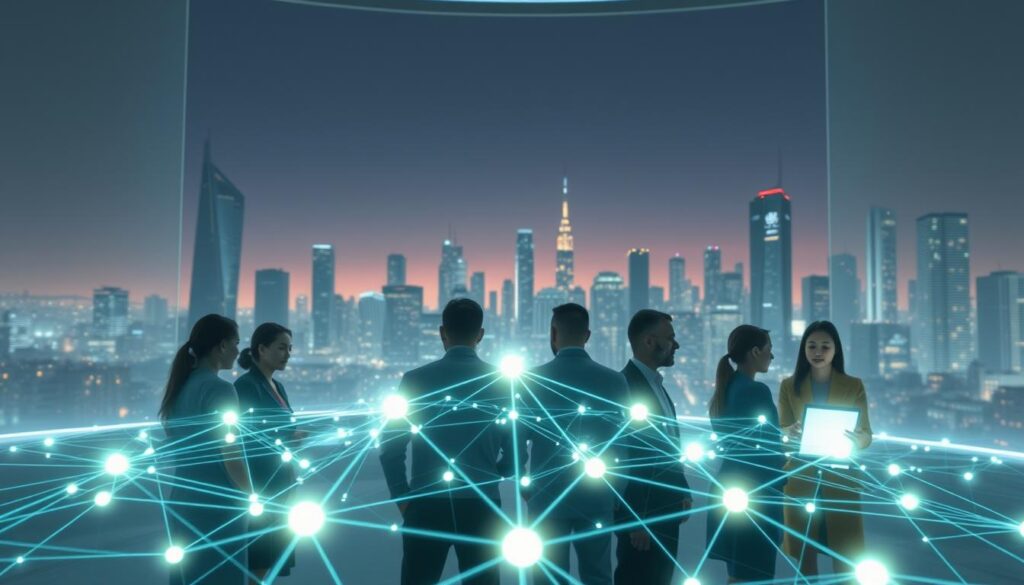Now Reading: Blockchain Art: Transforming the Future of Art
- 01
Blockchain Art: Transforming the Future of Art
Blockchain Art: Transforming the Future of Art
The creative landscape is undergoing a seismic shift through digital innovation. In 2021, a groundbreaking sale at Christie’s auction house changed perceptions forever. A single digital artwork fetched $69 million, catapulting its creator into global prominence and proving the immense value of modern creative expression.

This watershed moment revealed new possibilities for creators and collectors alike. Unlike traditional systems dominated by elite galleries, emerging platforms now let anyone participate in ownership opportunities. Prices start under $1,000, making rare works accessible to broader audiences.
Major institutions quickly recognized this potential. Auction giants now host dedicated sales for digital pieces, while global brands launch exclusive collections. For instance, a telecom leader unveiled limited-edition works by a celebrity chef in 2022, blending culinary mastery with cutting-edge tech.
The true power lies in transparency. Every transaction and ownership record remains visible and secure through decentralized systems. Artists gain lifelong royalties through smart contracts, ensuring fair compensation as their work appreciates.
Key Takeaways
- Digital innovation redefines ownership and value in creative industries
- Accessible pricing opens investment opportunities beyond traditional elites
- Historic sales validate digital works as serious financial assets
- Decentralized systems ensure transparent transactions and provenance tracking
- Corporations increasingly leverage digital collectibles for brand engagement
- Smart contracts enable ongoing artist compensation for secondary sales
Understanding the World of Blockchain Art
Digital creativity found its roots decades before pixels became collectible assets. Early experiments in the 1970s used computers to generate geometric patterns and algorithmic designs—works that would later inspire today’s dynamic cryptoart scene.
Defining Digital Art and Its Evolution
From pixelated graphics to AI-generated masterpieces, digital creations have transformed through four key phases:
- 1970s-1990s: Basic computer-generated shapes and experimental animations
- 2000s: Software-powered designs and interactive installations
- 2010s: Algorithmic art and social media collaborations
- 2020s: Tokenized works with verified ownership
Pioneering platforms like Monegraph and Rare Pepe demonstrated how digital collectibles could gain value through scarcity years before NFTs dominated headlines.
From Traditional Canvas to NFT Revolution
The 2017 ERC-721 standard changed everything. This tech breakthrough allowed creators to mint unique tokens representing their work—finally solving digital art’s authenticity crisis. Projects like CryptoPunks became cultural milestones, proving virtual ownership could rival physical art markets.
Today’s creators blend multiple formats—animated loops, 3D sculptures, even programmable poetry—all secured through decentralized systems. These innovations empower artists to build global followings without relying on traditional gatekeepers.
The Mechanics Behind Blockchain and NFT Technology
Trust in digital ownership relies on two groundbreaking innovations working in tandem. These systems verify originality and protect creative rights through mathematical precision rather than institutional oversight.

How Blockchain Secures Authenticity
Imagine a global spreadsheet updated simultaneously across millions of computers. This decentralized ledger records every transaction chronologically, creating an unbreakable chain of custody. Once entered, data becomes permanent – altering it would require changing every subsequent block across all network copies.
For creators, this means their work gains an unforgeable birth certificate. Each piece’s creation date, ownership transfers, and sale history remain transparent. Collectors can instantly verify a work’s legitimacy without third-party validators.
Unpacking Digital Certificates and NFT Provenance
Non-fungible tokens act as tamper-proof seals for digital files. These unique identifiers contain cryptographic proof of scarcity and origin. Unlike traditional certificates, NFTs self-validate through their underlying code.
Three critical features define their power:
- Immutable records: Ownership history can’t be erased or rewritten
- Automatic royalties: Smart contracts send payments to creators on resales
- Cross-platform verification: Authenticity checks work across marketplaces
This system transforms how we perceive value in digital spaces. A GIF file might get copied endlessly, but its certified original maintains provable scarcity through its unclonable token.
How to Create, Buy, and Sell Blockchain Art
The digital revolution has democratized creative ownership, letting anyone transform ideas into certified assets. Platforms like OpenSea and Maecenas simplify this process through intuitive tools for creators and collectors.

Step-by-Step Guide to Minting Your Digital Masterpiece
Start by perfecting your digital artwork using professional tools like Photoshop or Blender. Ensure files meet marketplace specifications—common formats include PNG, MP4, or GLB for 3D works.
Follow these steps to tokenize your creation:
- Select a blockchain network (Ethereum, Tezos, or Flow) balancing fees and environmental impact
- Upload files to your chosen platform and add descriptive metadata
- Set royalty percentages for future resales using smart contract features
- Pay gas fees to finalize your NFT’s blockchain registration
Navigating NFT Marketplaces and Art Platforms
Over 80% of buyers use general platforms like Rarible, but niche sites attract serious collectors. Specialized markets like Portion showcase curated collections, offering better visibility for unique pieces.
Key considerations when choosing platforms:
- Commission rates ranging from 2.5% to 15% per sale
- Community features like artist profiles and collector forums
- Integration with crypto wallets like MetaMask or Ledger
Smart buyers verify creator histories and check transaction records before purchasing. Always use secure wallets and enable two-factor authentication to protect digital assets.
Empowering Artists and Collectors with Blockchain Art
Creative professionals now wield unprecedented control over their work’s financial journey. Decentralized systems flip traditional models, ensuring creators keep more earnings while building lasting connections with supporters worldwide.

Maximizing Royalties and Ownership Through Smart Contracts
Gone are the days when galleries pocketed half an artist’s earnings. Cryptoart platforms let creators retain 80% or more of initial sales. Even better—smart contracts guarantee automatic royalty payments every time a piece resells, typically 10% or higher.
Three revolutionary changes:
- Lifetime income streams from secondary market activity
- No chasing payments—funds transfer instantly via code
- Full transparency in pricing history and ownership transfers
Connecting Global Art Communities with Decentralized Technology
Geographical barriers dissolve as collectors discover emerging talents from Lagos to Seoul. Specialized platforms enable:
- Real-time collaboration between creators across continents
- Fractional ownership options through NFT investment platforms
- Secure forums for discussing trends and valuing works
This global network thrives without gatekeepers. A college student’s digital sculpture can gain traction alongside established names, all verified through tamper-proof records. Collectors enjoy confidence knowing every piece’s origin and value trajectory remain publicly accessible.
Embracing the Future: A New Era in Blockchain Art
The fusion of technology and creativity is reshaping how we perceive value in the digital age. While challenges like energy consumption and market fluctuations persist, solutions emerge through scalable systems and evolving legal protections. Energy-efficient networks now process more transactions per block, reducing environmental impact without compromising security.
Market maturity brings stability as institutions develop valuation frameworks for digital works. This shift attracts serious investors while protecting creators through automatic royalty systems. Legal advancements address intellectual property concerns, ensuring authenticity verification and granting artists control over reproductions and derivatives.
Integration with virtual spaces and improved interfaces will expand accessibility, bridging traditional enthusiasts with tech-forward collectors. As corporations invest in infrastructure, the market gains sophistication—balancing innovation with artistic integrity remains crucial for lasting success.
FAQ
How does decentralized technology verify the authenticity of digital pieces?
Decentralized systems use cryptographic hashes and timestamped records to create an unchangeable history of ownership. This ensures each piece’s origin and transaction trail remain transparent, reducing fraud. For example, Beeple’s “Everydays: The First 5000 Days” utilized this method to confirm its uniqueness before auction.
What steps are involved in minting a digital creation as an NFT?
Minting involves uploading your work to platforms like OpenSea or Rarible, attaching metadata, and paying gas fees (usually in Ethereum) to register it on a distributed ledger. Once minted, the token acts as proof of ownership and can be traded or sold globally.
Can creators earn ongoing revenue from secondary sales?
Yes. Smart contracts allow artists to embed royalty clauses (e.g., 10% per resale) directly into NFTs. Platforms like Foundation and SuperRare automate these payments, ensuring creators benefit even after the initial sale.
Are there eco-friendly alternatives for NFT minting?
Some networks, like Tezos or Solana, use energy-efficient consensus mechanisms. Ethereum’s shift to proof-of-stake also reduced its carbon footprint by over 99%, making it a greener choice for environmentally conscious creators.
How do collectors ensure they’re purchasing legitimate digital works?
Buyers should verify provenance through blockchain explorers like Etherscan, check the creator’s verified social profiles, and use trusted marketplaces. Projects like CryptoPunks provide clear ownership histories to avoid counterfeit issues.
What distinguishes cryptoart from traditional digital files?
Unlike standard JPEGs, cryptoart ties ownership to a unique token on a distributed ledger. This tokenization prevents duplication and grants exclusive rights, similar to owning a signed physical painting but with embedded resale royalties.
How secure is ownership stored on decentralized systems?
Ownership records are encrypted across multiple nodes, making tampering nearly impossible. Even if a platform shuts down, tokens remain accessible via wallets like MetaMask, as seen with early NFT projects like Rare Pepe.
What trends are shaping the future of tokenized creativity?
Innovations include fractional ownership (e.g., platforms like Niftex), virtual galleries in metaverses like Decentraland, and AI-collaborative tools. These developments expand accessibility and redefine how audiences interact with digital culture.














